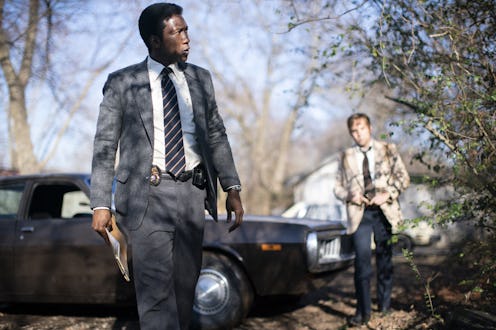
True Detective Season 3 finds the return of several elements that caused people to fall in love with True Detective in the first place. However, Season 3 has more in common with Season 1 than just sharing multiple time periods, a buddy-cop dynamic between two detectives, and a Southern gothic setting. The connections between Season 3 and Season 1 of True Detective goes deeper than visual similarities, they also set their sights on similar villains who are united by their crimes and a crucial symbol that shows up in both series — as well as real life.
The Purcell case consists of two related crimes, the death of Will Purcell and the disappearance of Julie Purcell, and the beginning of the investigation is dedicated to eliminating suspects and motives. When it seems clear that the kidnapping was not done for a ransom, detectives Wayne Hays, Roland West, and much of the Arkansas PD turn their attention to the possibility that Julie's abduction is related to acts of sexual violence or child trafficking.
They're not the only people who have that suspicion, as documentarian Elisa Montgomery suspects that the disappearance of Julie could be related to trafficking. As she tells Wayne in an interview, some believe that the dolls that were found in connection to the Purcell children could be a "sign of pedophile groups — like the crooked spiral."
Elisa then shows Wayne an image of a spiral triangle, which appears similar to the spiral that was found on Dora Lange's back in the first episode of True Detective Season 1, and is the same as a symbol the FBI believes is used by pedophiles, according to an alleged 2007 FBI document leaked by WikiLeaks. Elisa later mentions that "two former Louisiana state police stopped a serial killer associated with some kind of pedophile ring. Despite evidence of accomplices, the case never went wider," showing an image of Rust and Marty from Season 1. Elisa's theory is that the children were cold off by a family member, possibly their uncle, to a pedophile ring much like the ring hinted to in Season 1.
The connections stop there, unless the show's season finale decides to have Rust and Marty break down a door to lock up Hoyt and uncover a state-wide trafficking conspiracy, but the show makes it clear that the reference to the characters isn't what's important to the show's writers — it's the connection to similar crimes.
Elisa states that the crime is similar to "the Louisiana and Nebraska cases," which some fans might read as an announcement that Season 4 will take place in Nebraska. However, show creator Nic Pizzolatto took to the comments section of an Instagram post to explain "She was alluding to the Franklin, Nebraska scandal from the '80s, which is real and which she mentioned in an early ep."
Still, whileTrue Detective seems to share a clear plot connection between Seasons 1 and 3, it's more likely that they're related only by their respective allusions to the same real-life symbols and scandals concerning missing kids.